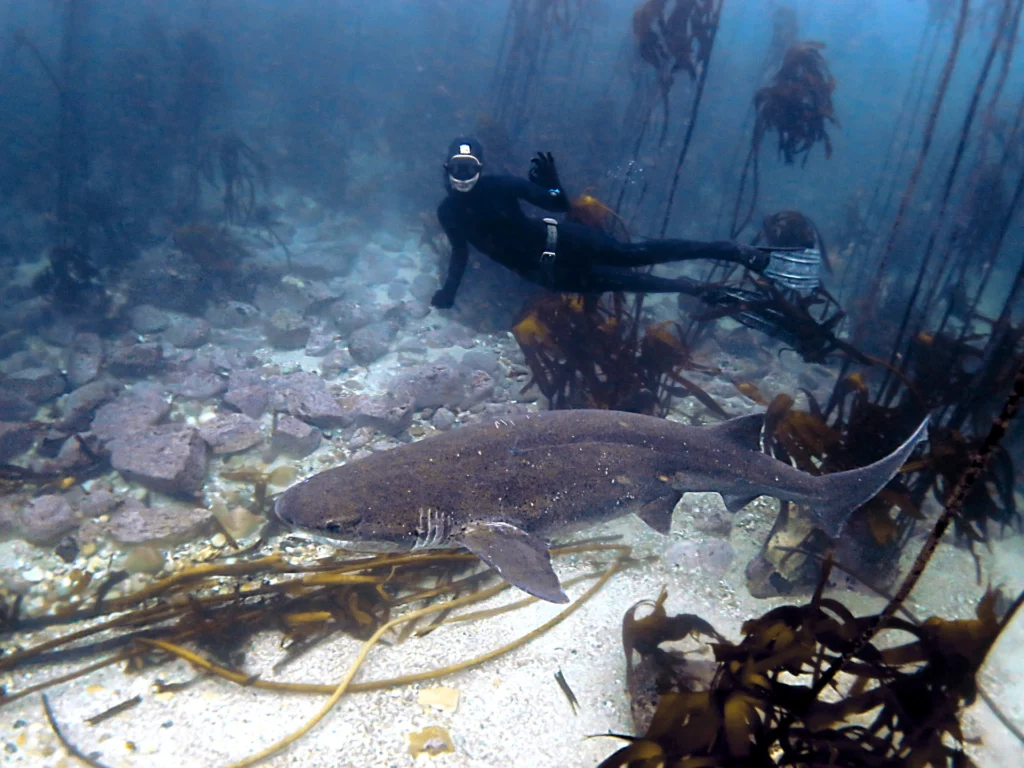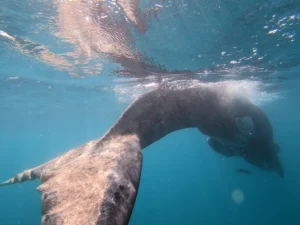Cape Town Freediving Clip Of The Week 8:
It wasn’t too long ago that freediving with 7-gill cow sharks in Cape Town was easy and if you wanted it to be, a regular activity. For the last 4 years though, spotting a cow shark on a dive has become a rare treat. Stephan and John were lucky enough to spot one of these prehistoric looking beauties on a dive at Glencairn, smack bang in the middle of a winter storm. We can’t say this enough, winter is the best time for freediving in False Bay!
The Broadnose Sevengill Cow Shark (Notorynchus cepedianus) is easily identifiable by its single dorsal fin which is set far back along the spine and its seven gill slits. It is quite a chunky shark and females average 2.2m, but can grow up to 3m in length. Males tend to be shorter at 1.5m. Like many other marine animals including the African Penguin, the cow shark is counter-shaded with silver grey on its top half to help it blend in with the water and seafloor below it and a pale belly to help it blend in with the bright sunlit water above it. It also tends to have some black and white spots scattered around on its body.

We used to regularly freedive and swim with these sharks in Shark Alley. On some Pure Apnea freediving courses we had up to 12 large cow sharks swimming around us. There are a lot of spots dubbed ‘Shark Alley’, so just to clarify, this Shark Alley is the section of in-shore kelp between the Miller’s Point club house and Castle Rock. Then one day… they were gone! The reason for their disappearance has been attributed to the disappearance of the Great White sharks. The Great White sightings began declining in 2017 and by 2019 there were no more sightings of these apex predators. Two main theories have been put forward for the disappearance of the Great Whites. The first is the appearance of 2 shark-hungry killer whales named Port and Starboard. They started visiting False Bay to snack on juicy shark livers. Some people believe that the Great Whites decided to migrate up the east coast to get away from these orcas. The second theory is that commercial fishing of smooth-hound sharks and soupfin sharks depleted the Great Whites’ main food source. Contrary to popular belief, Great Whites feed mainly on smaller shark species and only supplement their diets with the odd seal. With the Great Whites gone, the cow sharks became braver and moved further offshore where they replaced the Great Whites around Seal Island. It is quite funny to think that these placid sharks have replaced the Great Whites as the main attraction for one of the top adventure activities in Cape Town… shark cage diving!
There have been a few reports of in-shore cow shark sightings lately, so hopefully we will see more of these awesome creatures. Fingers crossed!



